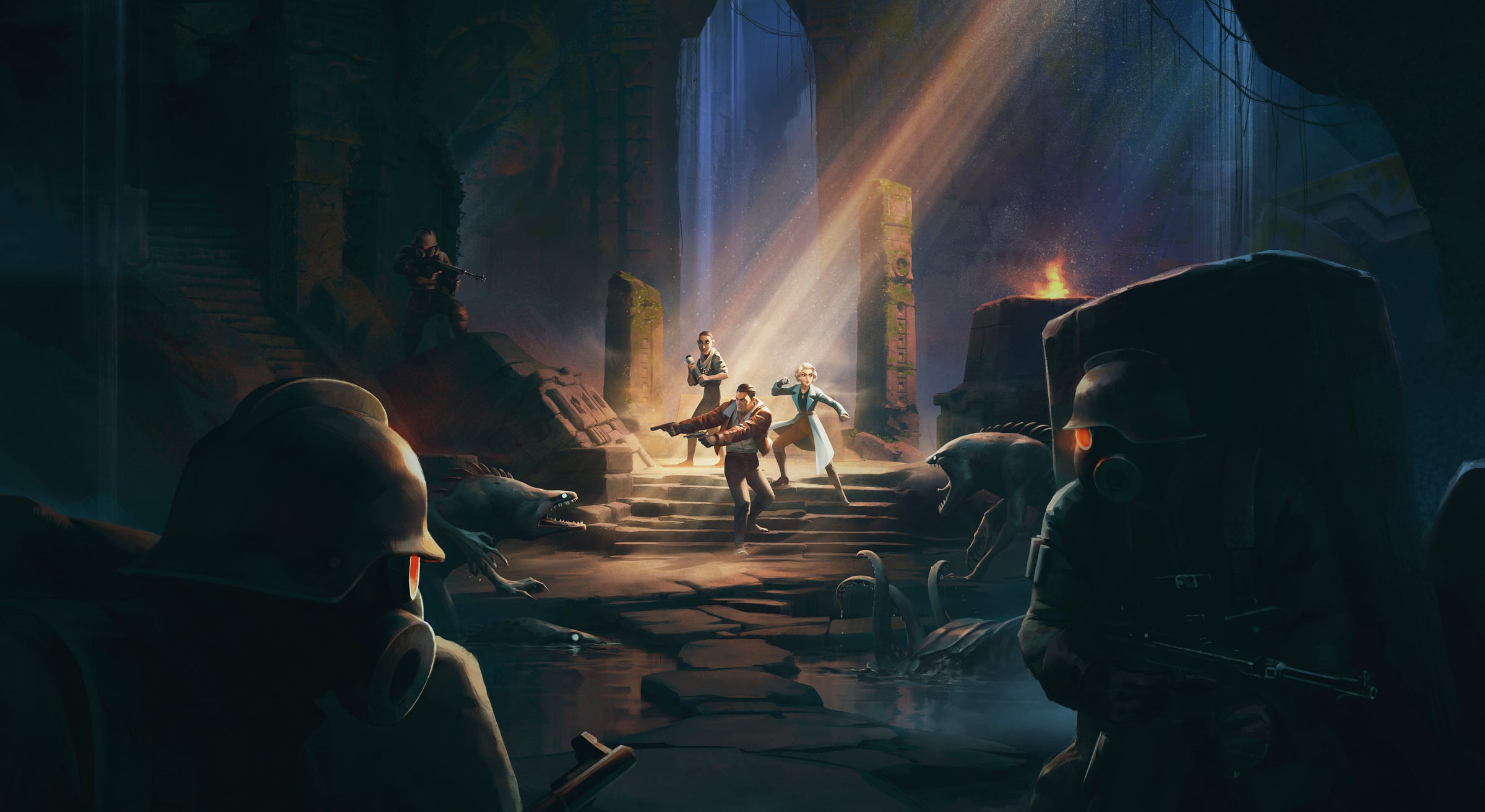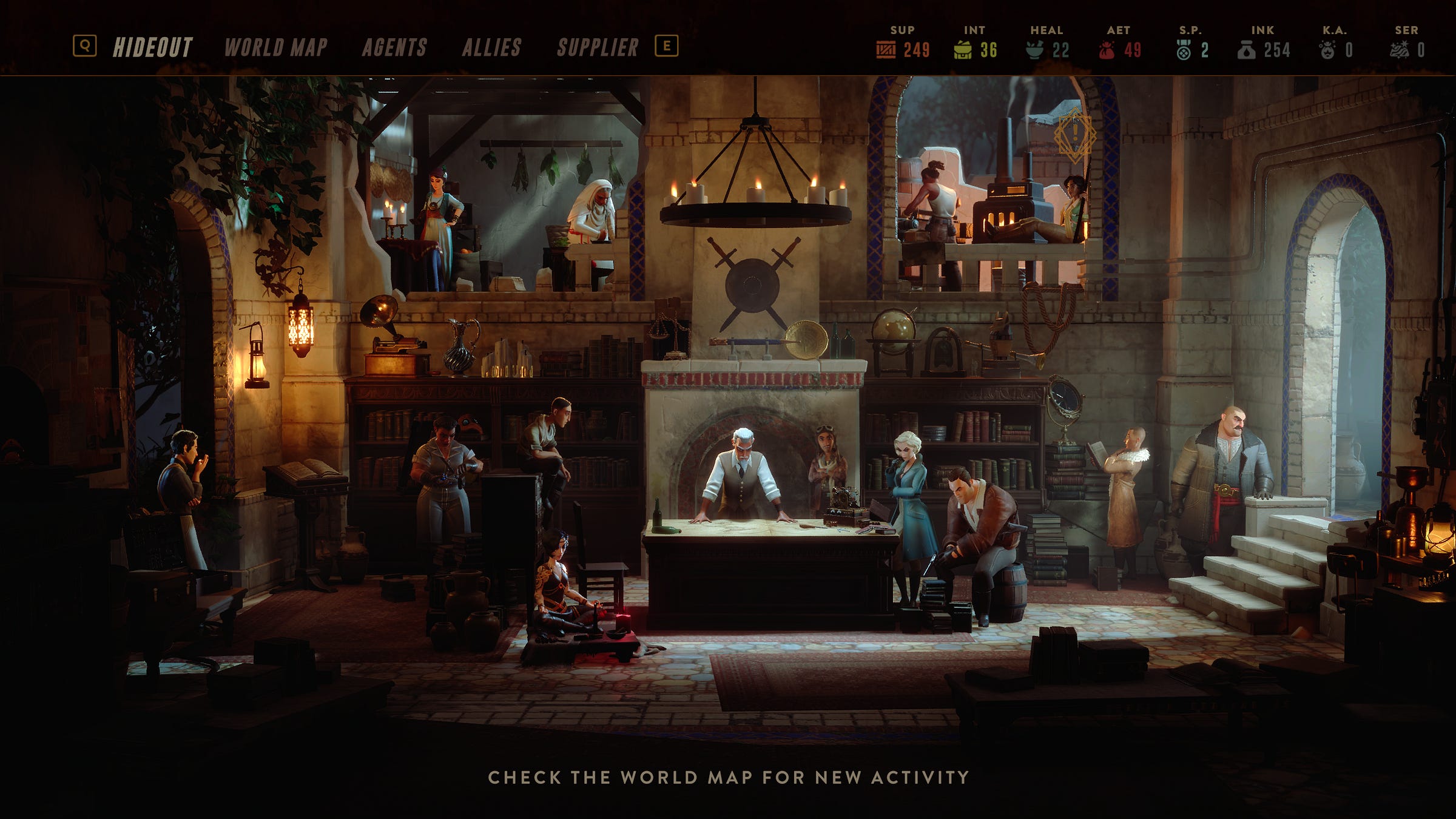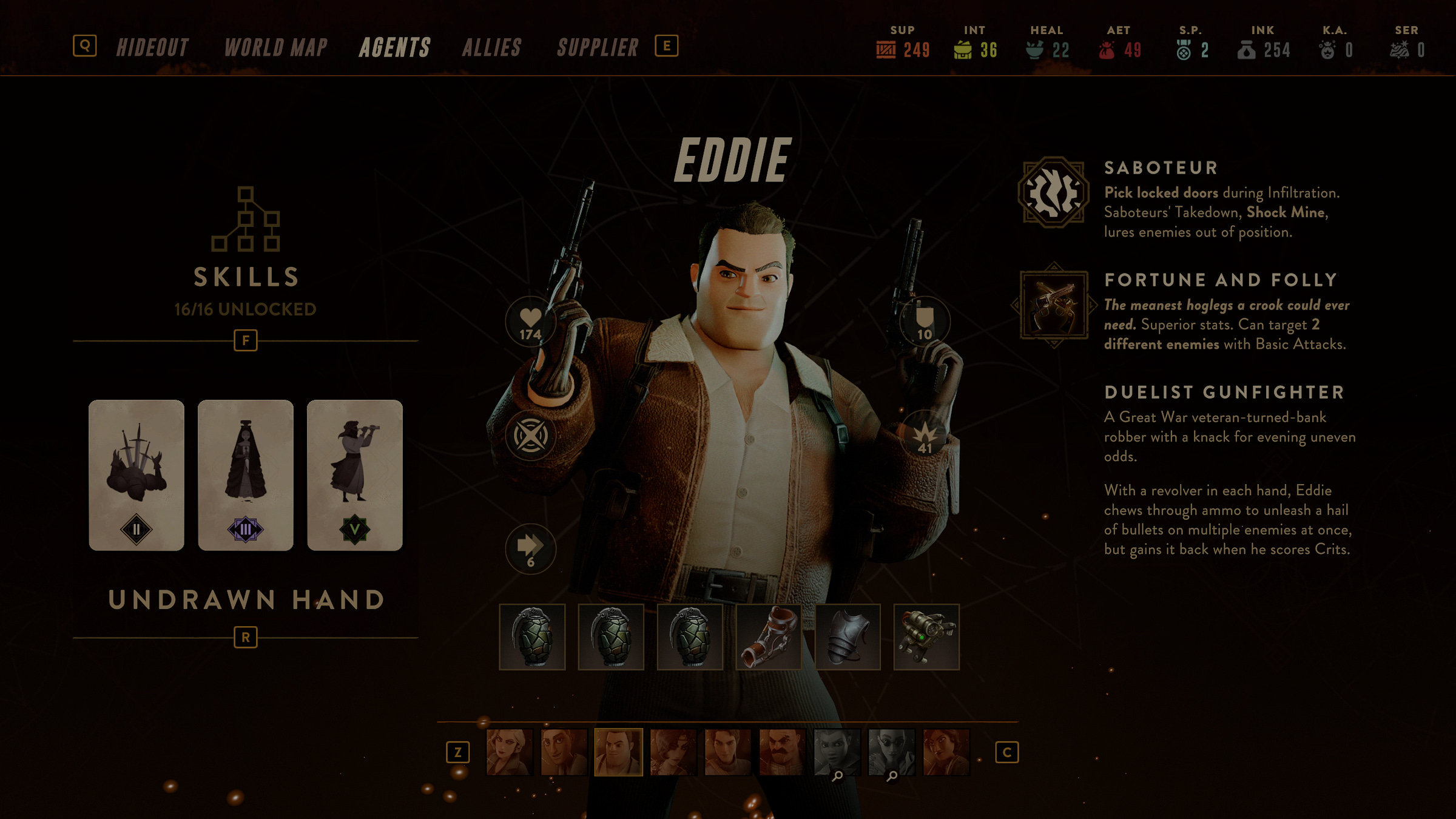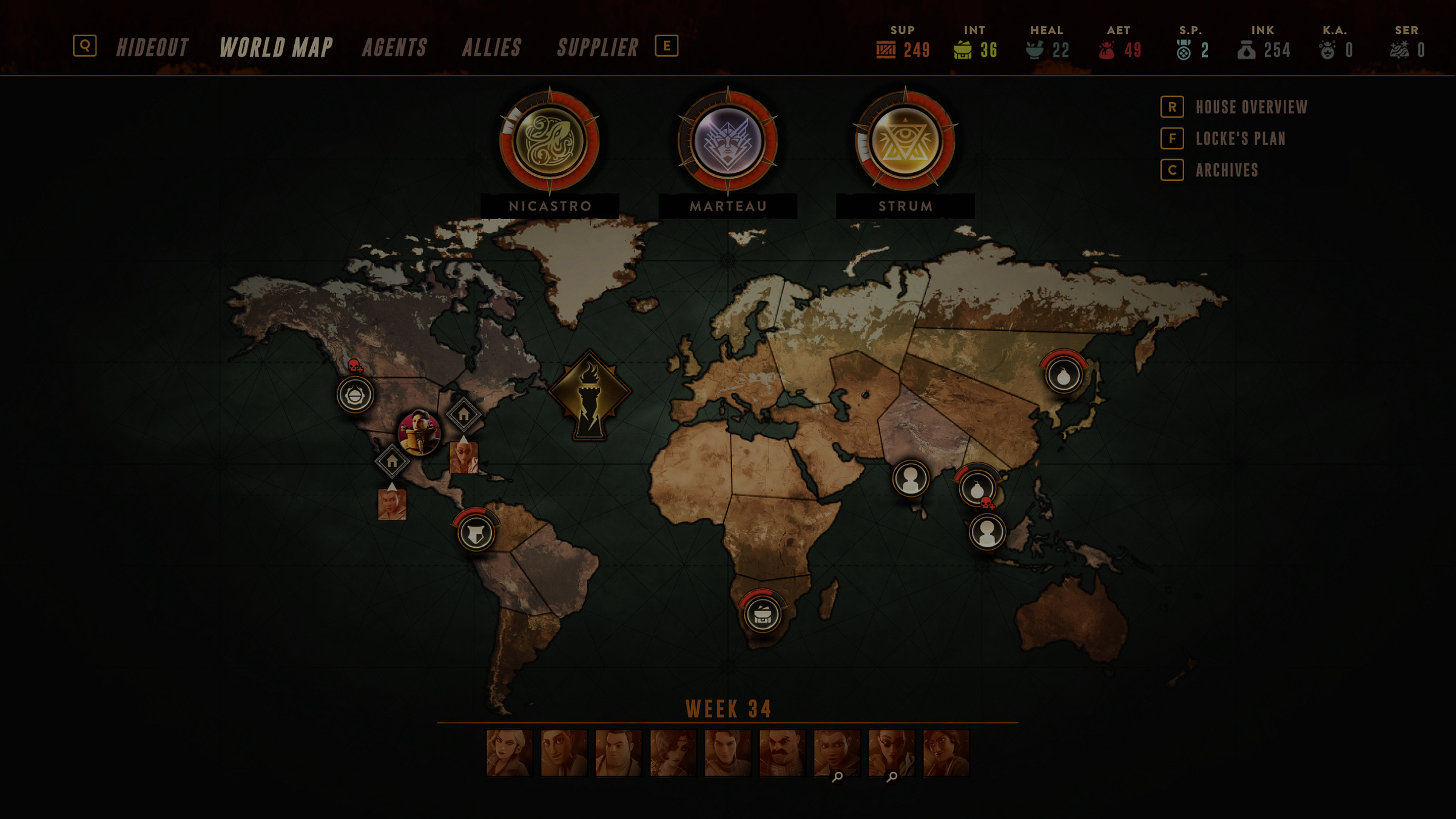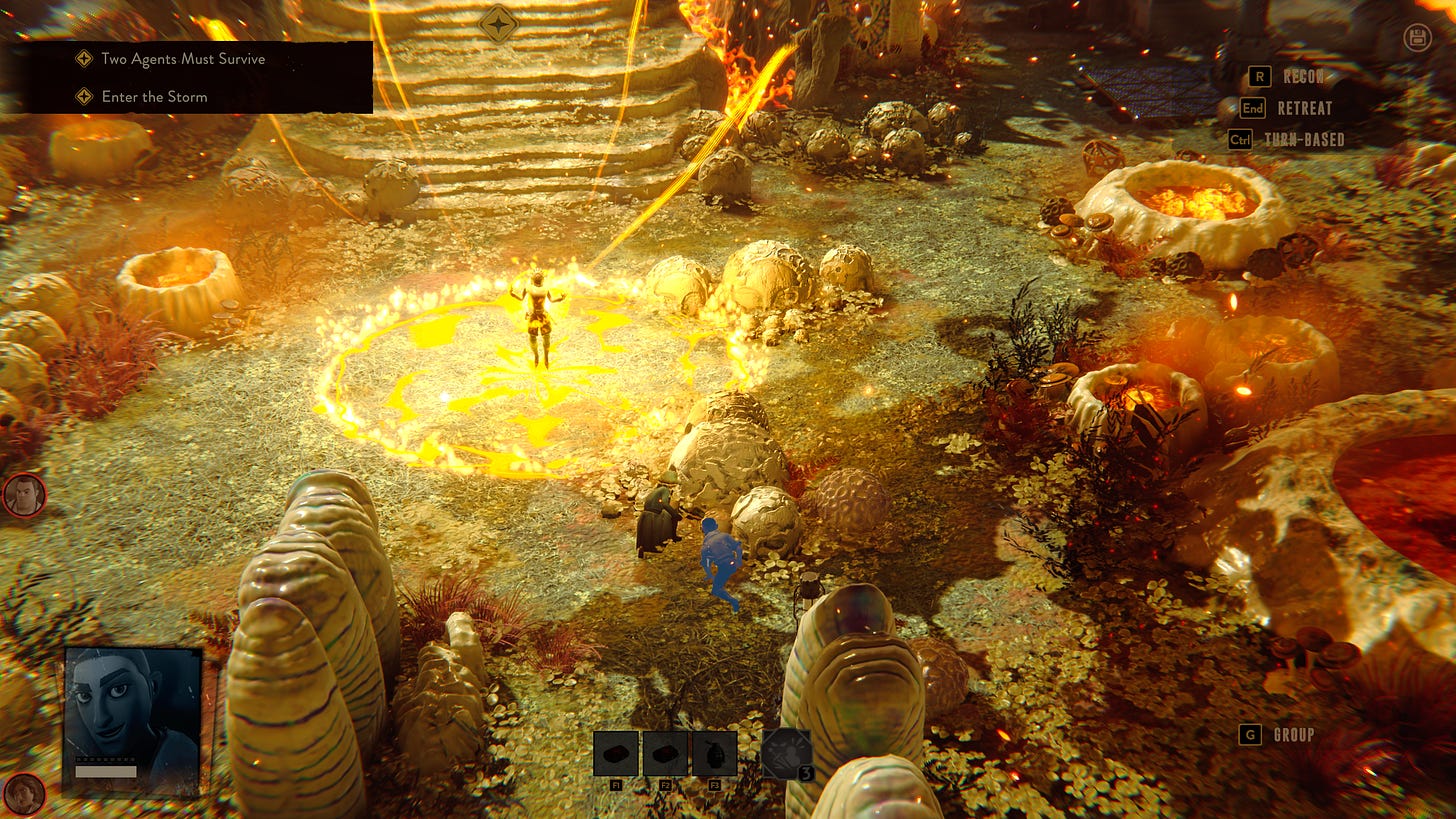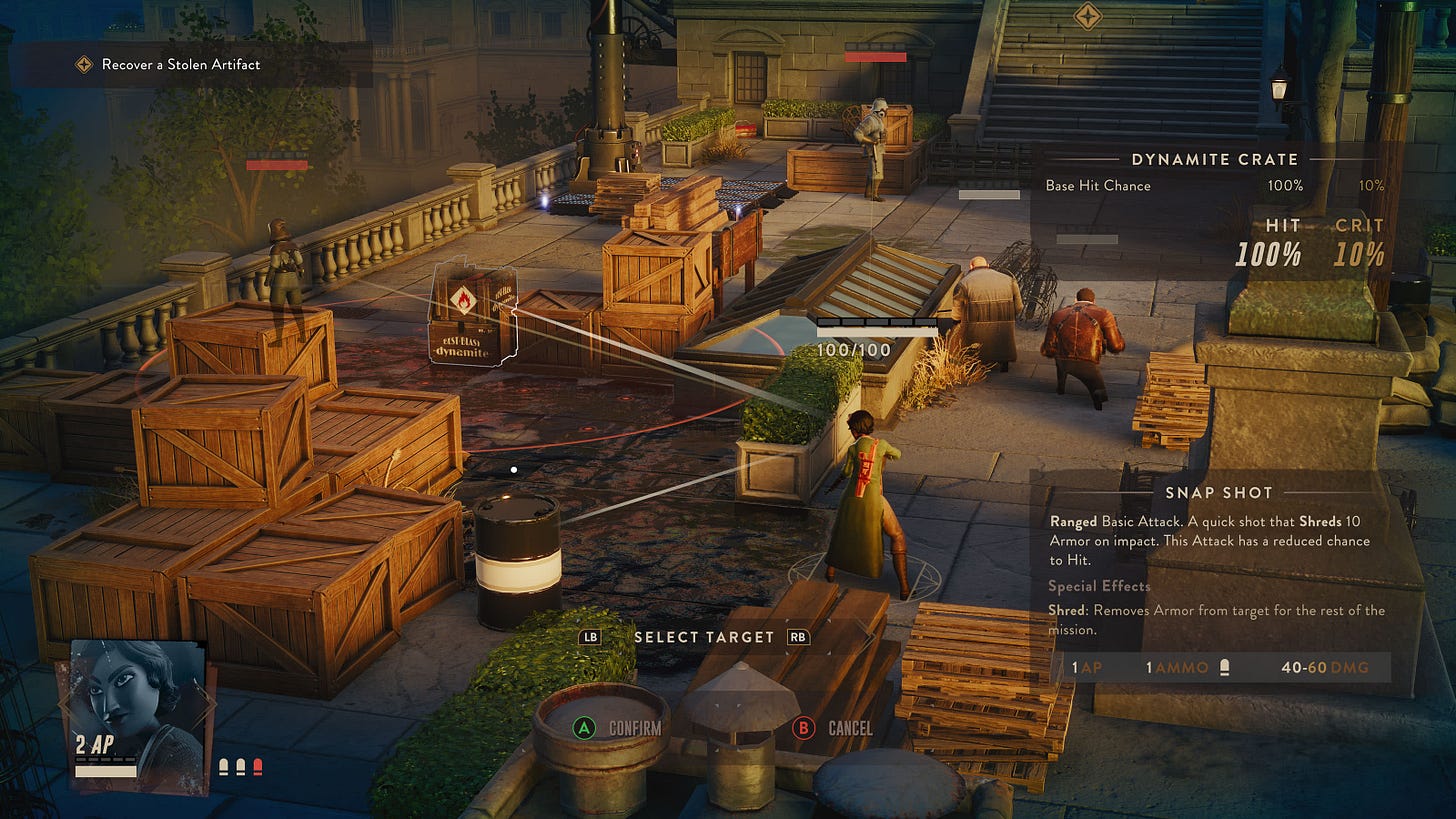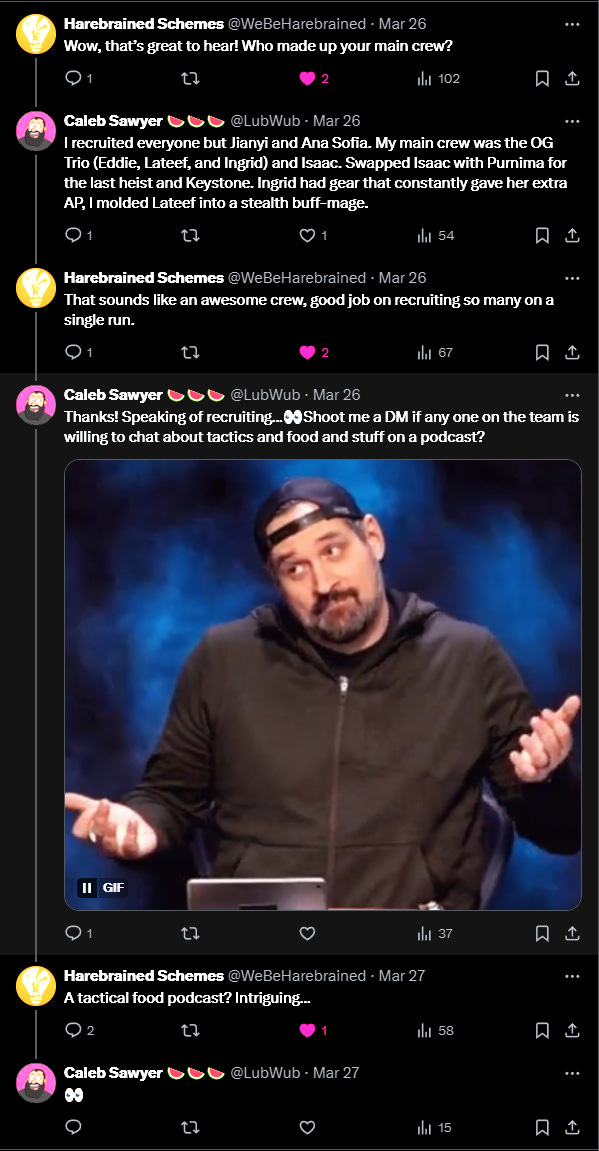Lamplighter's League: Solving the Cube
A Tactics Game, A Colored Cube, and Finding Solutions
The scene opens on a dark alleyway. The bricks and cobblestones lack defining features, but it’s dark, and the camera pans quickly. A terrified figure darting from border to border. A man stumbles and scrambles from one alley, crosses the street, blunders through a few passersby, tucks an envelope into his jacket, and returns to his furious retreat. Or perhaps he’s approaching a destination? He seems convinced of his pursuit, despite his pursuant’s absence. He winds his way through a few more shadowy corridors and emerges on a street. Whatever he’s running from, it has clearly impacted his spatial awareness, his hunter is skilled. A truck narrowly misses him, spiraling onto the curb adjacent. Awash in the truck’s headlights we see him again tuck the envelope into his jacket, but this time a single card drifts to the ground. As it comes to rest an image clarifies on the surface, like a rorschach ink-blot. A skull, tentacles climbing out of the eyes, giving the appearance of horns. The Roman numerals ‘LXII’ appear at the top. Sixty-two. AS the man reaches the next alley he attempts to catch his breath. Behind him, within the shadows a figure takes form, bright, blue, angrily slanted eyes take him in. The man gasps, the hunter lurches toward the camera. On a rooftop, elsewhere, but in the same city, a blonde femme fatale drags from a cigarette and exhales a sinewy cloud. “The courier is late,” she says.
When I first sat down to play Lamplighter’s League it was a full two months post its release. I remember seeing the trailer at a Summer Game Fest and being immediately intrigued. Harebrained Schemes, the developer, was a studio I had long grown fond of. Battletech was a revelation. The Shadowrun series an all-time classic. I had also become familiar, after a fashion, with composer Jon Everist. Jon had leant his talent to both the Shadowrun games and Battletech. It would have been, and is still, safe to assume anything with HBS’s name attached to it, is an easy sell for me. The fact turn-based tactics games are a sort of salve for my frequently melancholic brain only added to my interest. At any given time I have a minimum of five TBT games installed on my PC. Lamplighter’s mix of pulp-noir and tactics felt like toasting a peanut butter and jelly sandwich: hardly revolutionary, but the different approach to a thing already so deeply loved felt like eureka. What if X-COM but Indiana Jones? Yes. Please. Now. Offers forearm for IV drip. Right here in my veins please.
Tactics games are my Rubik’s Cube. Which I am just now realizing isn’t a great metaphor because I fucking hate Rubik’s Cubes. But hear me out. The trick to any Rubik’s lies in the pattern needed to solve them. I am going to poorly represent this, again because I have never learned this pattern in earnest and therefore do not fuck with the Rubik’s. But the idea, the fact, remains. Rubik’s Cubes are ubiquitous because they serve as a mental exercise. You poke and prod this compact puzzle until you suss out its core mechanism. Once you’ve divined said mechanism you exploit it until you can solve the puzzle, at first with difficulty, then eventually with ease. You’ve seen a video or three of a kid solving a Rubik’s behind their backs in less than a minute. It’s awe inspiring. And also deeply frustrating. (Author’s note: I just discovered its Rubik’s and not Rubix. I had to change every previous spelling in this paragraph. Anyway.) This is the TBT game for me.
It started with XCOM in 2012. I watched my uncle play Enemy Unknown, the brilliant X-COM reboot by Firaxis, and a little fire sparked in my belly. I went back to school in the fall and thought about it until I got some money for Christmas. I bought it my first week back in January. The way I absorbed myself into X-COM was extraordinary. It was my first real encounter with something built in the style since I played chess as a kid. While I’m not entirely sure there was a clear correlation there, the reality is my brain immediately went to work on X-COM like it was a job. The process of learning the systems, optimizing my squad, learning different approaches to combat, reacting to new enemy types, and interacting with the economy between engagements became a type of formula. All parts of a bigger, rolling mechanism made to drive players from the first moment of the game to the last.
Part of the allure to games like these lies not just in the rubik’s metaphor, but also in the blank canvas it gives you narratively. All of these games have Stories, with a capital S. But rarely do they lay the burden of said story on the shoulders of their characters. Part of the systems of a turn based game is your ability to cope with losses in your ranks. The lack of amelioration for these losses drives players to adapt and evolve their strategies as time progresses. The incredible YouTube creator and now game developer Mark over at Gamemakers Toolkit has a video addressing some flaws in this system, most notably the lack of leveling ability for units not on-mission with you. Lose enough people and you’re forced to start at ground zero with new recruits in a campaign you’ve progressed halfway into.
Sometimes, however, developers take a chance on making your characters, well, characters. My first experience with this being the surprise dropped X-COM: Chimera Squad. Rather than a horde of nameless recruits, you’re given control of a task force full of characters with personalities and dialogue. Losing one of these agents in mission results in mission failure and a restart from a previous checkpoint. As the game progresses then, you become deeply familiar with your squad. Who they are, how they talk, and the narrative building left to the player merely fills in gaps. It was an intriguing concept to me.
Part of this fantasy of playing games is about solvable problems. In a way, it’s the fantasy with all games, isn't it? Humans live in a world full of unsolvable variables. Today perhaps more than ever, though I’m still not sure if recency bias hasn’t made us believe it’s worse than it ever has been. Knowing this is fully a new conversation, The point I seek to make is this: video games are closed systems with clear goals and visible rewards. For most people this is Game 101. For my students, and many people newer to games, this is a bit of a revelation. I have written in the past about how specific games have cured bouts of depression, Skyrim saved my life after all. And yet, for all of their ability to incentivize and reward progress, nothing really ticks my brain like tactics. Part of this comes from the state of the world and my small place in it. But over time I have learned to make a sort of peace with this part of my brain. The other part of this stems from my whole-hearted aversion to most forms of organization.
When it comes to work, like paid, on a jobsite, employee-style work, I can organize extremely well. When it comes to self guided tasks or reminders about home keeping, I turn into a space cadet. I’ve struggled with it for years. Or, more accurately, my wife and I have struggled with it for years. Tactics games are perhaps the only place my organizational skills get flipped on and cranked to max. To anyone who has watched me stream tactics games, I apologize, I’m sure it is insufferable. Every level is a new puzzle to solve, every enemy a different chess piece to topple, every side objective a required task. If there is one genre of game I can be consistently relied upon to seek out some kind of min/max scenario, it’s tactics. Specifically turn-based tactics.
Lamplighter’s League is, simply put, one of the more fresh and exciting takes on the TBT genre. You play as new recruits to the recently resurrected Lamplighter’s League, a clandestine organization of honorable members of society, committed to doing what it takes to prevent the advancement of evil. Only, the original Lamplighters have all died and in a world descending into crisis, Pelham Locke, the last surviving Lamplighter, is forced to recruit from more unsavory pools of humanity. Enter Ingrid, a pugilistic enforcer, and Lateef, the self-proclaimed Gentleman Djinn, a thief. It’s a rough start, to be sure. Quickly followed by Eddie, a dual-revolver wielding vet from the Great War, and we have our starter crew. Honestly, for all of the possible directions you could take a game with this setting, replacing the secret order of conscientious scions with a bunch of low-lifes with a common enemy is perhaps my favorite bit of Lamplighter’s League. Rather than wading through the sea of magnanimity a crew of Tony Stark-types would elicit, we get this nuanced and diverse cast of people who are rough on the surface but warm beneath their facades. Lateef calls himself the Gentleman Djinn, and he’s challenged on it constantly. Eventually you see between the curtains and realize, by and large, he’s a good person who took up a line of work known for painting its adherents as villains. This metric can be applied to almost all of the agents you go on to recruit. They are criminals to the everyday world, sure, but the bric a brac on their sleeves betrays their capability for tenderness and honor. A fact given service as Locke, the ringleader, comes to realize two thirds of the way into the game his assumptions were all wrong. It’s endearing. Alarmingly so. Or perhaps, Disarmingly so.
The meat of the game is set up as such: There are three major houses, these houses are led by dastardly Scions, these Scions are hunting for the Tower. The Tower may or may not be, but definitely is, in some way or another, the Tower of Babel. Should they reach it, they will take over the world. Your task is multi-staged and laid before you as so: You need to steal a key ingredient from each Scion’s operation and you need to filch four Keystones, objects designed to help you glean the location of this fabled (but very real) Tower. You are given a world map, dials to count up Scion influence, and a hideout where your agents repose between operations. In a move not dissimilar to X-COM’s brilliant expansion War of the Chosen, the Scions of these enemy houses: Lady Zorana Nicastro, Lord Wolfram Strum, and Trace Marteau, roam the world map and serve as heightened difficulty modifiers. Nothing says fuck off quite like absolutely needing to do a mission and realizing a Scion is going to be there. While they don't actively hunt you down in the exact same way as War of the Chosen, their constant presence serves as a pervasive stressor, especially as the game draws closer and closer to the finale.
Writing this piece has been particularly difficult. There is a modicum of self-responsibility I have to take here. It has been a minute since I wrote about a game at any length, but a good portion of the time meant to be directed at this article was taken up by other responsibilities. At one point everyone in my house was sick but me. When the sickness resolved family came down for Memorial Day. Almost immediately after family departed someone tried to steal my car. It’s been a crazy three weeks. But the fact all of those things happened also lent to a little breathing space for my brain. Prior to writing this I had the opportunity to speak with several folks from Harebrained Schemes. In those conversations I learned a lot about the people who put in the hours making this game. I learned about their contributions to the game as well, don't get me wrong, but the most interesting bits come from the things in the spaces between work and private personal life. Allie McNulty, a Senior AI Programmer at HBS, spoke with me at length about her love for boss encounters and AI in games. She went into detail about how each boss in the original Zelda game felt like their own little puzzles. She described raid bosses built to require cooperation and coordination. As she would describe these things, from her viewpoint and technical skill, I was able to recognize how she implemented these things in Lamplighter’s League. Brian Poel, Senior Director of Operations, was a different story. Being involved in the even-more-behind-the-scenes machinations of an industry already deeply obscured from public view. Together we chatted about what it looks like to roadmap a game based on the financing you have, how decisions get made in order to maintain momentum, and how creative heads can have a tendency to butt together. I spoke with Chris Rogers, Creative Director and Studio Lead at HBS. The topics ranged from where inspiration is drawn, to sticking with your creative vision, to just letting him praise his team for what they accomplished. Finally, I also spoke with Connor Fogarty, the actor responsible for Nicky Konstantaras, the pilot of the Lamplighters. Connor and I talked about everything. From Dune and Halo to the uncanny valley and Dragon’s Dogma’s FMV food.
The extra few weeks of distractions and obligations led to a deeper appreciation for these folks willing to share their time with me. It also allowed me to better hone my thoughts about the state of the industry, a topic which found its way into each interview. Here is this group of people making the things they love. Here I am doing something I love. How do I make sure to give their work the best spotlight? The time away from the keyboard helps clarify things in the mind. After all, it’s important to step back sometimes, reassess, and dive in another way. I wasn’t going to write anything initially, and here we are.
If the fantasy is solvable problems, the setting capable of providing you the power to solve anything is the turn based game. Time, as a finite resource, redefined. In these games you get to stop everything and take your turn at your own pace. Life…not so much. What I wouldn’t give to have a pause button when dealing with cranky kids, tough conversations, big life decisions. The trick, I’ve learned, is to be patient despite the fact our brains are in crisis mode. Over the last four years, since I quit GameStop during the first few weeks of lockdowns, I have slowly learned to forge this kind of patience. But I am also aware the opportunity I was given to learn this is not an opportunity open to everyone. I've essentially spent years alone. In silence often. At the risk of sounding esoteric, I found a sort of peace in stillness. I came across a quote a few months ago perfectly summing it up. “The Great Way is not difficult for those who have no preferences.” Yes it sounds very zen. Yes it’s corny. But the truth of the matter is, I have found it to be true. Life should be about the pause, the wait, the calm. Surrounded by apps and services begging for our time, it’s no surprise we more often find ourselves pontificating about what comes next rather than positioning ourselves in the present moment.
Almost every issue I encounter, I step beck mentally, try to observe what is happening, and remind myself to remain calm. Most things are temporary, most solutions are finite, and every little thing we encounter in life is a new moment to practice clarity. And I did it anyway. Risked sounding like a robed monk and fully came out of the other side clothed in saffron. The point is, I found a way, a bit roundabout as it may be, to slow things down before acting. I measure the playing field and weigh my options. I can’t save scum here, unfortunately, but the patience pays off. If only I could give everyone the opportunity to be sad and lonely for four years so they could learn themselves and their tendencies.
Without thinking about it, I found a way to implement the mindset I take into these kinds of games and apply it to real life. Perhaps what I am doing here is a bit of a stretch, but it makes sense in my head.
Last year I redownloaded Massive Chalice, an out of pocket tactics game with a Game of Thrones-esque lineage mechanic made by DoubleFine, originally released in 2015. I had played 80% of the game and dropped off for some reason or another. It wasn't really a game I expected DoubleFine to make, but it had all the right pieces and just the right twist of originality. I got back into it surprisingly quickly, the combat is snappy and crunchy, the between-match mini game of marrying houses together to create lineages of warriors is an incredible breath of fresh air. ButI quickly found out I had actually stopped playing closer to 90% through the campaign and I wrapped it in about five hours. I scratched the itch, but it only got itchier. I bought Showgunners, redownloaded Phantom Brigade, and started turning Battletech in my hand again. Then Lamplighter’s League landed in my lap.
My process for any new tactics game is to first push through the initial engagements and follow the rules. It’s a means of tutorialization, I understand. But Lamplighter’s instructional phase felt light and open to interpretation. I've also played enough of this genre I find myself skimming more than studying. How does AP work? If I attack, is my turn over, despite still having an AP left? How does overwatch play out? How literal is the cover system? Lamplighter’s was easy enough to parse. But when the game detailed the Undrawn Hand, little lights started flashing in my brain. The Undrawn Hand is a system built to give you abilities and passives, but they are doled out to you on a random basis at the end of each match. If you find yourself in possession of a card with a clear upside, slot it into a character, if it doesn't fit so well, break it down into ink. The system is simple, but it adds an ability to build nuance into characters with strong archetypes. By the halfway point, Lateef, my thief and stealth infiltrator had been transformed into a buff mage. He could grant increased movement speed to two characters, remove negative status effects, and guarantee critical hits on a player-character’s next attack. Lateef’s archetype is broadly the jester. He’s a distraction dealer, with a dummy he can place to draw fire and cloak himself, blinding/aggro drawing coin tricks, and a buff to evade for every move action he makes. By the aforementioned halfway point, his diversionary tactics were last ditch advantage savers. If Ingrid got over extended, Lateef would run in and make everyone focus on the dummy. If Eddie got hit by a blinding effect and Ingrid got knocked prone, Lateef could cure those ailments and get them rolling again, restore an AP for everyone, and then he could blind a group of four, making Ingrid far more lethal.
The Undrawn Hand is the unsung hero of Lamplighter’s League. The diversity of loadout jumps exponentially when you have a full squad of agents on a Key Mission. For this reason I found myself playing with the same starter three throughout most of my playthrough. I dabbled in some Isaac, tempted fate with Celestine, ran fades with Ana Sofia. The closest I got to replacing a member came as I was building up Isaac. In fact, in the four man missions (as most only allow you to send three) Isaac was my go to number four. His Lewis Gun positioned him as a tremendous asset of area denial and consistent damage. Add in his abilities to heal on crits and deal more damage when overheated and I quickly fell in love with his ability to deal large amounts of damage. I even got a shock mod for his gun, which would apply shocked to ten or fifteen percent of his hits. But everything changed when I recruited Purnima.
Part of the problem solving a Rubik’s cube, or so I have heard, is once you figure out the formula you can apply the same methodology to every Rubik’s cube. This is only slightly verifiable information for me, but the concept translates well to tactics games in my experience. Because every tactics game breaks down once you have a high level sniper. It’s a known quantity for me at this point. I first learned how broken snipers were in these games with X-COM. I upgraded my sniper as fast as I could. Her skill tree had one truly obvious path, in my eyes, and I outfitted her with the best gun and armor I could find. The key element being the armor. Enter the Archangel kit. See, the Archangel allowed flight, and given to a sniper with Squadsight, Damn Good Ground, Executioner, and In The Zone, your sniper could essentially hit anyone, kill most of them, and get actions back when you did. I only achieved this build in the late game, a fact I am extremely grateful for, because it made almost every engagement a cake walk.
Often this is where the tactics genre begins to come unglued for me. Solving the puzzle of the game in such a massive way it makes the challenge dissolve like cotton candy. I have no problem with cotton candy in the first few bites. The sweet, spun sugar treat, is fun to interact with, but eventually the sweetness wears on me. Similarly, once I have the equation cracked in a tactics game, unless the game finds a way to counter me or increase difficulty, I find myself getting tired of winning so easily. But scaling difficulty in a game where the player’s ability often is incalculable (due to the high level of customization), is a tricky biscuit to bake. Everyone has a memory of a game suddenly getting harder on you, knocking a few of your teeth out, and leaving you in the dirt, coughing blood and staring at the sky asking yourself, “what the fuck was that!?” How do you compensate for power creep without nullifying player choice?
Purnima became my scalpel. My squad already had the mid to close range game down. Ingrid, with her AP restoring knockout abilities, and Eddie, with his crowd control buffed by Lateef’s auto-crit buff, made light work of nearly every engagement. But I struggled with the long game. To its credit, Lamplighter’s League scales difficulty extremely well as the game progresses. The clocks ticking ever forward for each House gradually increase the capability of the enemies you face. Simultaneously, as those clocks progress, the mission difficulty increases, meaning more enemies and wider variety. Purnima’s addition felt like meeting a long lost sibling. A friend you can strike up a conversation with no matter how much time has passed since you last saw them. Because Purnima was a sniper, and what’s more, she was a sniper with abilities buffed by targeting enemies with the “marked” modifier. Eddie’s Light ‘Em Up ability applies marked to enemies he crits. Auto-crit Eddie, hit six targets with Light ‘Em Up, mark a gaggle of baddies, thin the herd with Purnima, beat the shit out of the rest of them with Ingrid. My Lamplighters became a machine of death.
I immediately began to look for the signs of cotton candy fatigue. By the time I recruited Purnima I was fully four fifths into the game. I had already done two of the heists and I had stolen three of the four Keystones. As such, the clocks for all three Houses were nearly full. In talking with Creative Director Chris Rogers I asked if there was truly a doomed state in the game. What would have happened if I had let one of those clocks fill up. The game tells you if a House reaches a full dial they win. Chris chuckled and said there was, in fact, a last chance mission offered to players who allowed things to get out of hand. I didn't know this in my playthrough though. So I recruited Purnima, maximized my squads lethal potential, and then, out of fear, did the last Keystone and final Heist without completing the prep missions. It was the perfect storm of anxiety and semi-preparedness. The final heist was Tough, with a capital T, but because I had my perfect solution in my back pocket, the challenges thrown at me became trials. Each segment a new problem, like I was rock climbing. I could see the route I needed to take, knew the tools at my disposal, and had learned how to leverage my advantages. Honestly, the endgame of a tactics game has never felt so rewarding.
Beneath all of the joy of playing this game my mind constantly returned to the specter of Harebrained Schemes being newly independent. It was no secret the marketing for Lamplighter’s League was lacking. My mind returns to the releases of games like Titanfall 2, doomed to fight for survival between Battlefield 1 and a Call of Duty title. Lamplighter’s League wasn't beset on both sides by massive titles, but it was released in the infamous fall surge of games. Companies like to bolster their End of Year fiscal reports by launching titles in the holiday. I get it from an actuarial standpoint, people buy games in the holiday season, it perfectly buttons up a year of fiscal reporting, and if everyone else is doing it, why not join the fray? But the problem I have always had with this release window is it braces dozens of games against each other, all of them vying for attention and sales. I’m not an accountant, and I wasn't smart enough to ask Brian Poel about his opinion of this release window while I had him on the show, but the whole season makes me as angry as it does excite me.
I already stated I didn't play Lamplighter’s until January. Already I failed to be a contributory consumer in their most important stretch. By the time I played, Paradox had already severed ties with the studio, post a series of layoffs. The industry has been marred by this. We have all read countless press releases of closures and corporate waistband tightening. What I am eternally grateful for, in this case, is Harebrained Schemes’ separation and not closure. It makes you wonder why studios like Tango Gameworks and Arkane Austin, two of the more recent shutter jobs, aren’t given the same escape hatch. I’m sure, for some tax centered reason, it makes more financial sense for a big corpo to close instead of sever ties, but the process fucking sucks. We all remember Zaslav and Warner canning the Wile E. Coyote movie Coyote vs Acme. Remember Batgirl? A fully finished film shelved for tax reasons? Bullshit. All around, all time low, bullshit. Why Harebrained got their freedom instead of a bullet shaped email from corporate is beyond me, but we are all lucky they are still around. In conversations with the team I know the next few months are going to be scary and tough as they hunt for funding, but they have the opportunity to try and persist.
They say Luck is what happens when opportunity and preparedness meet. I have some problems with this, but those problems are better saved for a more thorough and thoughtful discussion I think. In my own experience, I can say, I have gotten lucky by simply being an amicable conversationalist. The jobs I have been most proud of came, in my own estimation, because I was able to speak to people and make my character known. The luck was getting the conversation started. Over time, as I have run NerdyBits, I have learned how to get better and better at this. I have interviewed more than a dozen people. People I am extremely proud to have had the opportunity to talk to. Each “yes” feels lucky, but it’s a manufactured luck at this point. Far less the result of happenstance and readiness. Take this series of interviews with HBS. I tweeted about loving the game and added a bit of wishful thinking, hoping to catch the eye of a dev or two. When the HBS Twitter account (I refuse to call it X, because it’s stupid) replied to me I thought, “hmmm…perhaps I can turn this into something.” When the something turned into a phone call with Chris Rogers I might have peed a little. All of this to say, it feels less like random luck to me than it feels like learning where to look. Do I feel lucky this all happened though? Yes. Perhaps there is space for a little oxymoron in life. A little paradox. But I find it far more productive to stop hoping to get lucky and instead take luck as far out of the equation as you can.
The key to my success as I wrapped up Lamplighter’s League came from finding ways to strong arm the game's chance system. Every turn-based tactics game has one, in one way or another. Your troops are positioned in one way, the enemy troops in their own, you take a shot, the game calculates the odds of you being successful, rinse, repeat. With my squad I could almost completely eliminate this system. I could force critical hits, mark enemies, knock them down, and then stack prone and “marked” bonuses with lethal melee and long range attacks. I rarely worried about chance. I simply shifted the table to my benefit and then made them pay.
When I finally fought Trace Marteau for the first time it was in the final mission. In the Tower. He never got a turn, Purnima shot him for over 800 damage and we moved on to the next challenge. Strum, a Scion I crossed sabers with frequently, pushed over like a stack of rotten bricks. Lady Nicastro, on the other hand, as a final boss, was an absolute slog. But my squad managed. Lateef buffed his fellow agents every chance he got. Purnima became a mid to short range overwatch terminator. Eddie forced as many enemies as he could out of cover. Ingrid just kept beating ass. When Nicastro finally went down, the game prompted me to send someone into the Bright Storm, to finally end the conflict. I wish I could tell you there was a debate about who I was going to send. I knew immediately.
Each of the characters you encounter in Lamplighter’s League feels real. Whether they are a Russian mob enforcer or a begrudged Engineer, each of them have a reason to be there. Eddie had to learn his reason, but as he came around, and Ingrid took notice, I immediately began shipping them. I hoped, should things all work out, they would find time to find love. Somewhere in their scarred souls. Lateef was the wildcard. From the beginning he was the man with big ambitions. The Gentleman Djinn! It was fun watching him defend his magnanimous title to Celestine, another sneak who knew having a renowned title meant you weren’t exactly living up to the whole sneak gig. When Lateef was pressed on some of his stories he would cave, explaining how circumstances led to different outcomes than what was widely perceived. He was the thief with a heart of gold. But he didn’t want anyone to know it.
Each character had to deal with the realization the world they thought they knew had stranger and darker elements to it than they could have imagined. The first encounter with Strum's resurrected mummies, Nicastro’s drowned beasts, or Marteau’s ghostly shades sent each of them spiraling down their own paths of awakening. I’ll always remember Lateef, voice small and subdued in this moment, saying what was on everyone’s mind, “I can’t believe this is real.” I imagined him in the Tower, at the end, fighting to save the literal world from evil and darkness, realizing something new. Something he knew all along. He was the one. He wanted to be remembered. We all do. But in the Tower he figured out why he would be remembered.
While Ingrid, Purnima, and Eddie argued about who should be the one to save their skin, Lateef became the sneak once more. They bickered, in a bittersweet way, who should be the one to draw the short straw. There was posturing. Eddie tried to play the man card. “Let me be the one to take the fall.” He always seemed like he had demons he was afraid he couldn’t outrun. Ingrid wasn’t keen to let Eddie act like he was the only one who could do it. “I don’t need you deciding my fate for me.” Purnima was newer to the group, but she’d lived life as an assassin, surely she could atone for some of her sins now. “I know we’ve only just met, but if you knew what I’ve done, this wouldn’t be an argument.” But it wasn’t an argument. In their quarrel Lateef had already ascended the stairs, placed a hand on the barrier between dimensions and looked back at the scoundrels he’d learned to call friends. “The Gentleman Djinn bids you farewell.” He said. I imagined tears in his eyes and a puckish smile across his face. Startled, the group turned their heads upward. But before they could utter a word, the world's greatest thief pushed through the barrier and brought the terror to an end.
Lamplighter’s League is a brilliant game with a heart ten times larger than it has any right to be. Every moment carried me to another place, transported me into a new body. I grew to love this ragtag group of ne'er do wells who were given no other option but to do good. The tactics, the meat and potatoes mechanically, are sound. Progressively challenging, deeply explorative, and full of thump. The character work will consistently surprise you with golden nuggets of development and growth. Also, and this can’t be said enough, the setting fucking rules. Pulpy, sci-fi, Lovecraftian. Like the brainchild of Indiana Jones, Tomb Raider, and X-COM.
Lastly, and perhaps most importantly, the folks at Harebrained Schemes are a stellar crop. They are kind, they love what they do, and their track record shows they are incredibly skilled at what they do. While I don’t think further sales reach them monetarily, play this game and let them know how much you love it. They deserve all of the flowers. Fingers crossed they find funding, because I’m pretty damn sure what’s coming next is going to be good too.
~Caleb
@LubWub



